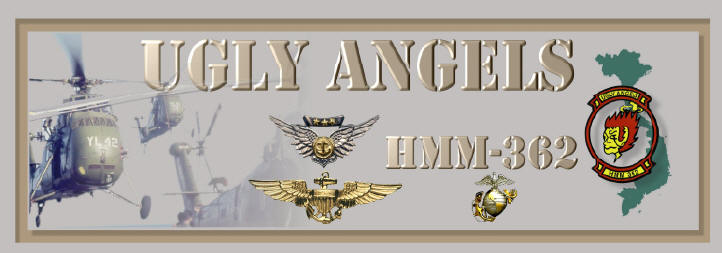Vietnam- 25 Years Ago
By Tyler Bush
Reprinted from Leatherneck, August, 1987
The deployment of a Marine helicopter squadron and
supporting units to Soc Trang was an historic event. The Marine presence
in Vietnam would eventually grow into the Third Marine Amphibious Force.
Tension hung in the air as USS Princeton
(LPH-5) sailed through the South China Sea. The Marines of Marine Medium
Helicopter Squadron 362 (HMM-362), Marine Aircraft Group 16 could sense
something was about to happen. The squadron commanding officer, LtCol
Archie J. Clapp. had just called the men together for a briefing.
It was announced that before daybreak the following
morning, April 15, 1962 the darkened ship would pull to within 20 miles of
Vietnam. We would make a landing via helicopter. We were to establish a
base camp at the village of Soc Trang, Ba Xuyen Province. Our unit was to
be the first Marine operational organization committed to South Vietnam.
Our mission was to provide air mobility for Vietnamese Civil Guard units
and ARVN Ranger assault units. We would return fire only if fired upon.
The following morning we awakened to the humming of
the ship’s elevators lifting helicopters, blades folded back, topside. We
left the stifling heat below deck, clutching rifles with sweaty palms. As
soon as we stepped out topside we knew we were in a different world. Even
at this early hour, the heat was so intense and muggy it felt like trying
to breathe through a pillow.
“Archie’s Angels,” named after our CO, boarded HUS
choppers and shuddered off toward the Mekong Delta, wondering if we were
going to get shot in the next hour or two. Soon the choppers were hop
scotching over lush green foliage and skipping over water-filled rice
paddies. In a few minutes we slid into an old Japanese airstrip three
miles from the tiny village of Soc Trang. ‘Operation Shufly had commenced!
The airstrip had an old hangar into which we could pull
our aircraft to work on. There were a few rooms that became offices for
operations, administration. etc. Tents were erected for the troops in
what was to become known as ‘Tent City.” Fresh water had to be trucked in
from Soc Trang. Rubber tanks soon held chopper fuel, also trucked in. In
less than 24 hours we were operational. although the first combat troop
lift was not requested for a week. We had 24 HUS helicopters, three OE-l
observation planes and eventually 250 men available for duty.
A Vietnamese mortar battalion and infantry battalion
provided perimeter security. Inner defense and internal security was
provided by our own men. Language was a major problem both sides
had to make decisions more than once whether a man would not obey a “halt”
command because he could not understand, or if he was really an enemy.
There was also a language barrier between our helo pilots and Vietnamese
support pilots - very dangerous when you need “moment’s notice” help.
We received mail twice a week when the C-130F transport
plane supplied us. Usually we also got enough warm soda pop on those
flights to last a day or so. To many of us,. that warm pop was almost as
rewarding as mail call.
Dust blew so thickly around the base area that at times
it was hard to see 20 feet. One minute it would be dry; then thick sheets
of rain would come down, and in a few minutes we would be up to our ankles
in water and mud. Tents often were blown down, soaking everything and
everyone. At night we slept, rifles at the ready, under mosquito nets that
barely slowed down the swarm of bugs that left our skin sore and itching
with red welts. Rats that seemed as big as cats had a fondness for
crawling into the sack with us.
The operations provided us with additional on-the-job
training and helped polish our expertise in helicopter support. We learned
to never make the same approach to a target area, thus setting up a
pattern. Viet Cong set up long, sharpened poles at some sites, trying to
herd our helicopters into certain fields of fire when dropping off assault
troops. We also had to make sure troops headed in the right direction
after leaving the chopper. It was easy for them to become disoriented.
Dummy troop landings were made to drive enemy troops
into ambush. At times it proved beneficial for the flight leader to stay
“high in the sky.” giving directions to his helicopters swooping in at low
level on a mission. Also the use of ‘Eagle flights.” (airborne troop
reserves) were made. They stayed in the air until needed somewhere, then
landed at a moment’s notice.
Many supply runs were made to the village of Father Hoa
(the “fighting priest”), located on the southern tip of the Vung Mao
Peninsula. There were no supply roads leading to his village of Binh Hung.
Once a much appreciated religious statue was helo-lifted in. R&R flights
were made to Saigon for a few hours, where one might have a terrific meal.
such as cows’ brains and fine wine, or other exotic food. There was
nothing better than their French bread. Back at Soc Trang we did not lack
good food, either. We had steak for many. many meals. The only thing
missed at base was cold drinks!
On the first of August 1962, HMM-362 was relieved by
another Marine helicopter squadron which eventually transferred to Da Nang.
in the northern part of South Vietnam. Da Nang became “home” for most
Marines throughout the remainder of the war.
